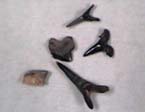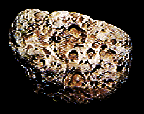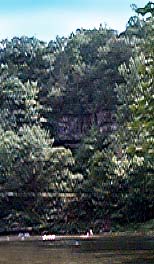The Stories Fossils Tell
 Fossils are the remains of plants or animals that have turned into stone. They may be bones or teeth or shells, an outline, or a shape pressed into the rock. Footprints and droppings have been found as fossils, too.
Fossils are the remains of plants or animals that have turned into stone. They may be bones or teeth or shells, an outline, or a shape pressed into the rock. Footprints and droppings have been found as fossils, too.
For a fossil to be made, the dead plant or animal has to be buried rapidly by sediment. The soft parts rot away, but the harder parts are preserved and hardened by the minerals of the dirt and mud covering it. Fossilization also occurs when the parts of the organism are dissolved away to leave an impression in the mud. The impression can act like a mold, and the next layer of sediment becomes cast in the same shape as the original living thing - just like you can make a plaster cast of your own or an animal footprint in the ground. See Make Your Own Fossils
As plants and animals die and are buried by mud and dirt, layers build up, with the older organisms on the bottom. By studying the layers, paleontologists (scientists who study fossils) can get clues to how living things have changed over the eons. These layers are also very important clues to dating the ages of the rocks.
Fossils and sedimentary rocks
SEDIMENTARY ROCKS and sediments underlie over 99 percent of all of Arkansas. Fossils are preserved in sedimentary rocks. Therefore, much of Arkansas has the potential of producing collectable fossils. Some types of sedimentary deposits contain much more abundantly preserved remains due to favorable conditions for life and preservation. A comparison between limestone and sandstone, both sedimentary rocks, will illustrate what I mean. Limestone quarries are often a source of abundant fossils especially when the sediment was deposited in shallow marine seas where life was abundant, such as on and adjacent to reefs. In a marine sand-depositional environment, life had a hard time not being covered up and buried by the intermittent influx of sediment, therefore, even though some fossils are occasionally recovered from sandstone units, they are fewer and farther between. In marine sand deposits, the fossils tend to be washed in plant material or free-floating animals, such as nautiloids, shark remains, and cephalopods, that did not have to stay on the ocean bottom and so could escape periods of sand influx.
The sedimentary rock record in Arkansas spans from Late Precambrian to Recent - some 750 million years. Much life developed and became extinct during this period of time. Although most life left no remains in the rock record, there are areas of Arkansas which have certain units of rock that contain relatively abundant fossils. The state is easily divided into 5 geographic provinces on the basis of the underlying geology and below are short writeups on each region's fossil collecting potential.
The Five Geographic Provinces
Ozark Plateaus. The Ozark Plateaus are a highly dissected region of north Arkansas. The sedimentary rock record represents shallow-water marine-carbonate environments which were eventually covered by transgressing deltas and swampy to lagoonal fresh-water deposits from the north. The local shoreline changed throughout the entire history of deposition, sometimes leaving marine reefs and limestone deposits exposed to weathering and sometimes drowning the freshwater coastline deposits with marine water and sediments. The predominant fossil remains in the Ozarks are invertebrates. A few early fish's and shark's teeth are sometimes recovered, but they are scarce. Crinoid, blastoid, bryzoan, coral, and mollusk remains are fairly typical. Trilobite parts are sometimes locally abundant, but complete remains are relatively scarce.
 A rock full of crinoid stems, found on a swimming trip in the Blanchard Springs Caverns area.
A rock full of crinoid stems, found on a swimming trip in the Blanchard Springs Caverns area.
 The local topography of the Ozarks consists of gently rolling to flat-topped hills and steep, relatively narrow, V-shaped valleys. Bluffs along steep hillsides, talus slopes, road cuts, headwater areas of drainages, and numerous rock quarries are the prime sites for fossil collecting. Some areas of limestone which were selectively silicified, upon weathering, reveal silica-replaced fauna in the weathered residuum and detritus. In the Mississippian-Pennsylvanian section of north central and northwest Arkansas, paleontologists and hobbyists actively search for sites yielding goniatites. Goniatites (a type of highly ornamented and sutured coiled cephalopod) evolved rapidly through time, leaving not only their shells, but a way to compared these older sections of Paleozoic rock with some details concerning time that we otherwise would not have. Any limestone outcrop is worth examining, and some shale-sandstone sequences present a wide variety of faunal types. Small local deposits of clay and sediment, developed in caves or fissures, may yield varied Quarternary vertebrate remains. Some local Native American sites have yielded some surprising species, including dire wolf, alligator, and peccary bones.
The local topography of the Ozarks consists of gently rolling to flat-topped hills and steep, relatively narrow, V-shaped valleys. Bluffs along steep hillsides, talus slopes, road cuts, headwater areas of drainages, and numerous rock quarries are the prime sites for fossil collecting. Some areas of limestone which were selectively silicified, upon weathering, reveal silica-replaced fauna in the weathered residuum and detritus. In the Mississippian-Pennsylvanian section of north central and northwest Arkansas, paleontologists and hobbyists actively search for sites yielding goniatites. Goniatites (a type of highly ornamented and sutured coiled cephalopod) evolved rapidly through time, leaving not only their shells, but a way to compared these older sections of Paleozoic rock with some details concerning time that we otherwise would not have. Any limestone outcrop is worth examining, and some shale-sandstone sequences present a wide variety of faunal types. Small local deposits of clay and sediment, developed in caves or fissures, may yield varied Quarternary vertebrate remains. Some local Native American sites have yielded some surprising species, including dire wolf, alligator, and peccary bones.
Arkansas River Valley. The Arkansas River Valley, located south of the Ozarks region, is floored by thick units of shale and sandstone. These units represent a rapid influx of clastic (particle) sediments that filled the area in Pennsylvanian time. The source of the sediments was predominantly from the north. The sequence reached above the sea level several times and for fairly uninterrupted periods because several layers of coal are present. Coal represents plant material which was deposited in water and accumulated, not suffering from the normal decay that occurs when organic matter is deposited on land. Rot, decay, fungi, and bugs soon lay waste to land-deposited plant matter (and animal matter, too) unless it is deposited in water. In a swampy area adjacent to a major river or near the coastline, deposition may continue uninterrupted for relatively long time spans. Accumulated plant material is then buried by accumulations of other types of sediment and begins the process of becoming coal.
Plant fossils are often abundant in the sedimentary units immediately overlying the coal in the Arkansas Valley. Ferns and other plant remains, such as casts of stigmaria and lepidodendron, are not uncommon, sometimes seen in vertical, life position in the encasing sandstone. Unfortunately, plant fossil sites in this region have become increasingly more difficult to find and collect due to the Federal program of coal mine reclamation. Many a good site has been lost for collectors.
Ouachita Mountains. The Ouachita Mountains consist of a thick rock sequence, some geologists estimate as much as 50,000 feet, which was deposited in a shallow- to deep-water ocean trench. A continent, which approached from the south some 270 million years ago, jammed the sedimentary units up onto the North American continent around 245 million years ago. During this process, the rock layers were bent, broken, shattered, and generally suffered serious disruption. The marine conditions present in this deep water environment resulted in only sparse fossils being preserved in the sedimentary rocks, and most of those being either free-floater type organisms, like graptolites, or remains of shallow-water organisms that slid into the basin from the north in great mud flows off the continental shelf.
West Gulf Coastal Plain. This area covers most of south Arkansas and is bordered on the north by the Ouachita Mountains region and on the east by the Mississippi Embayment. The area of Sevier, Little River, Howard, Pike, Hempstead, Nevada, and Clark Counties encompasses the most fossiliferous beds in the state. Shallow Cretaceous marine seas teemed with life, both invertebrate and vertebrate. Many roadcuts, ditches, stream banks and beds, and quarries contain outcroppings with abundant fossils. Mollusk shells are extremely common, especially very robust types, like Exogyra and Gryphaea, that could stand up to a pounding surf. In the gypsum mines, particular limy units are essentially a fossil hash, composed of a wide variety of small shells. Marine vertebrate remains, principally of shark, fish, mosasaur, and sparse reptiles, like turtle and crocodile, are sometimes recovered.
A few Cretaceous units are terrestrial in origin (non-marine) and these have yielded rare specimens of dinosaur bones, most notably the foot bones of a raptor, informally called Arkansaurus fridayi, and an incomplete hadrasaur. One of the longest dinosaur trackways in North America was discovered a few years ago at a gypsum mine in Howard County. A section of this trackway may be seen on the east side of the County Courthouse in Nashville, some 27 miles northeast of Hope from Interstate 30. There are several areas where Pleistocene petrified wood is relatively abundant, but it is poorly silicified and is generally only used for home flower beds and decorations. Tree trunk sections from a few 10s to over a 1000 pounds may be recovered from drainages, gravel pits, and along river banks from Quarternary deposits.
Mississippi Embayment: (Local usage calls this area the delta) The embayment is a region which is underlain by generally poorly consolidated to unconsolidated sediments. The sediments in this shallow basin were deposited during a variety of conditions, ranging from deltaic and terrestrial river systems, shallow near- to distant-shoreline marine seas, and even fresh- to brackish-water lake conditions. Fossil sites are relatively scarce, but when discovered may be quite prolific. Fish vertebra, shark and ray teeth, and shell remains, along with sparse large vertebrate remains, like Bacylisaurus (a primitive toothed whale) are present in marine deposits. The occasional large catfish skull may even be recovered. Quarternary gravel deposits that cover much of the area yield some cuttable petrified wood in the northeastern part of the state and sparse mastodon and mammoth remains.
To find out more about Arkansas' fossils, check on the following references:
Dane, C. H., 1929, Upper Cretaceous formations of southwestern Arkansas: Arkansas Geological Survey Bulletin 1, 215 p.
Easton, W. H., 1932, Pitkin limestone of north Arkansas: Arkansas Geological Survey Bulletin 8, 115 p.
Croneis, Carey, 1930, Geology of the Arkansas Paleozoic area: Arkansas Geological Survey Bulletin 3, 457 p.
Freeman, Tom, 1966, Fossils of Arkansas: Arkansas Geological Commission Bulletin 22, 53 p. Although the individual localities in this publication are largely gone, it contains considerable background information on fossils and the areas in Arkansas to hunt. Some good plates of fossils. Available from Arkansas Geological Survey
Note to Collectors: Please be aware that knowing about these minerals and where they can be found does not grant the right to trespass on private property or mining claims. Even if you consider taking some samples as "just collecting", property owners might consider your actions trespassing and theft. The status of mineral collecting on national forest and Corps of Engineers land is changing, and access is very restricted. Please check with the appropriate landowner, lease or claim holder, or district supervisor before attempting to enter a collecting locality.